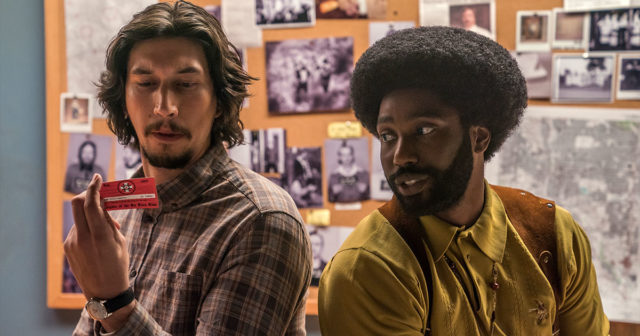
It’s a famous shot from one of the most widely seen movies in the history of cinema: Scarlett O’Hara searching desperately for a doctor in a sea of wounded and dead soldiers. As Scarlett searches, the camera cranes high into the sky; so high her dress blends into the rows of men dying in the dust. The music swells, a bugle sounds and the camera reveals a tattered Confederate flag waving in the wind. These are the men who fought to ensure the rights to enslave human beings. Gone With the Wind wants us to feel sorry for them.
Nearly 80 years later, that image still has the power to take our breath away. Spike Lee knows that. He knows images are key to understanding and shaping the world around us. That’s why he opens BlacKkKlansman not with the image of his hero Ron Stallworth (John David Washington) or his villain David Duke (Topher Grace), but with Scarlett O’Hara lost in the aftermath of the Civil War. And we’re still there, wandering among the carnage. How did we get here? Lee has a few ideas.
But, we’re getting ahead of ourselves. First, the story: Based on the memoir, Black Klansman by Ron Stallworth, the film revolves around Stallworth, Colorado Springs’ first black police officer. When Stokely Carmichael, aka Kwame Ture (Corey Hawkins), comes to town, Stallworth is assigned an undercover gig to infiltrate the Black Panthers. While at the rally, Stallworth meets Patrice Dumas (Laura Harrier), an activist with nothing but contempt for the police, and for good reasons. Without revealing his identity, Stallworth and Dumas begin a relationship; Stallworth was born to go undercover.
Then, almost as a lark, Stallworth infiltrates the Ku Klux Klan’s local chapter. Using his real name, Stallworth communicates with the KKK over the phone while Detective Flip Zimmerman (Adam Driver) poses as Stallworth for face-to-face meetings. The two Stallworths quickly work their way up the ranks, all the way to the KKK’s Grand Wizard himself, David Duke.
Duke isn’t the only character familiar to modern audiences. Neither are the slogans and chants KKK members whisper in secret or scream with emphasis. This story is not so long ago, and Lee easily breaks from conventional narratives to make his point.
In one sequence, Lee crosscuts between KKK members watching Birth of a Nation’s infamous finale — itself a virtuosic display of crosscutting and profound racism — and a Black Panthers meeting with Harry Belafonte recounting the lynching of Jesse Washington. When both stories reach their climax, Lee cuts between two images of arms outstretched in salute: one with fist closed, the other with palms outstretched like knives.
Lee allows these images to collide with one another. And collide they do, reverberating in our minds well after the lights come up. After watching Birth of a Nation in 1915, President Woodrow Wilson is alleged to have said, “It’s like writing history with lighting. My only regret is that it’s all so terribly true.” Those words are applicable here, but in a much, much different context. As the saying goes: “All power to all the people.”














